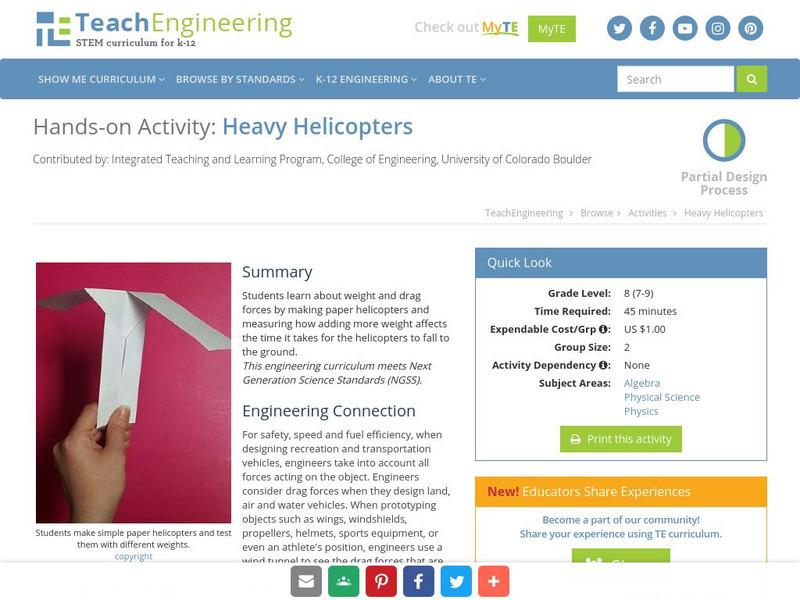Curated OER
Simple Machines
Third graders are introduced to the six types of simple machines and discover how they make tasks easier. In groups, they rotate between stations to experiment with the different types of simple machines. To end the lesson, they make a...
Curated OER
Transportation
Students explore basic transportation vehicles, specifically air, land, and water vehicles, name six different modes of transportation, identify four different kinds of train cars, and three differences between two different modes of...
Curated OER
Wright Flight
Students explain and explain the interactive relationships between forces of lift and gravity, thrust and drag, as they apply to airplanes in motion. They know that Orville and Wilbur Wright flew the first airplane based on these...
Curated OER
Who Invented It? When? Chinese Inventions: An Introductory Activity
Students use Robert Temple's "The Genius of Chins: 3,000 Years of Science, Discovery and Invention", to understand how much the Chinese have contributed with their scientific and technological ability.
Curated OER
Chinese Inventions A Selected History of Science and Invention in China
Students study the history of Chinese technology by identifying when and where items were invented or discovered.
Curated OER
China
Ninth graders are introduced to the many contributions China has made to the world. They research and choose an invention to find information on. They will have to use an internet resource tool to guide them for their presentation of...
Curated OER
Introduce Vocabulary: In the Small, Small Pond
Young scholars explore language arts by reading a story in class. In this vocabulary word lesson, students read the book In the Small, Small Pond and discuss several vocabulary terms used in the story. Young scholars participate in vocab...
Curated OER
Calculating the shortest distance between two points
Eighth graders find the length of the third side of a right triangle.
Curated OER
Eye From the Sky
Learners are introduced to the concept of aerial perspective and scale. Students will use satellite technology to view their neighborhoods and sketch the area surrounding their schools. They will take part in a neighborhood walk to view...
Science Education Resource Center at Carleton College
Serc: Paper Helicopters: Variables and Experimental Design
Introduce scientific design and variables through this simple lesson of building paper helicopters. Activity includes a link to a video on how to make helicopters.
TeachEngineering
Teach Engineering: Heavy Helicopters
Students learn about weight and drag forces by making paper helicopters and measuring how adding more weight affects the time it takes for the helicopters to fall to the ground.
Technovation
Curiosity Machine: Challenges: Build a Helicopter
Can you build a helicopter with popsicle sticks, rubber bands, paper clips, and cardboard that flies at least ten feet in the air and stays up for three seconds while carrying one penny? Use this site to accomplish this with a lesson...
Exploratorium
Exploratorium: Roto Copter
Students can experiment with a home-made helicopter that lets them change the blades to see how real aerodynamics work.
Other
Easy to Make Paper Airplanes
Have fun making different kinds of flying vehicles. You will learn how to make a paper airplane, helicopter, rocket, blimp, etc.
Science and Mathematics Initiative for Learning Enhancement (SMILE)
Smile: Lab Activity: Aviation
This site from the Illinois Institute of Technology provides a student lab activity in which the flight of a paper airplane is investigated and studied. Designed for primary grades, but easily adaptable for junior high students.
















